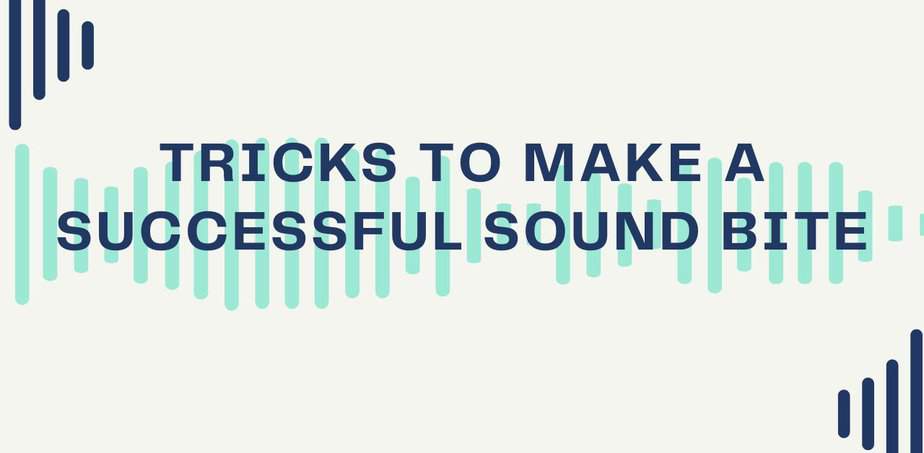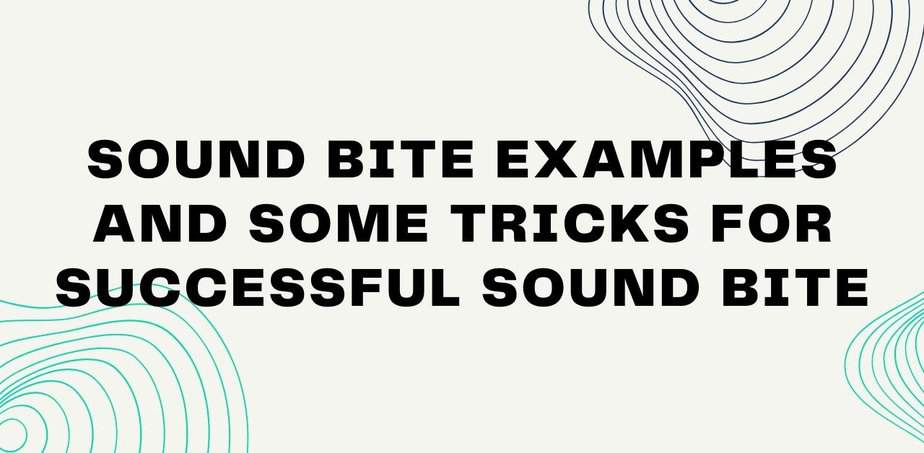You must master the art of creating effective sound bites if you’re a marketing or sales professional. Here are some pointers for creating well-phrased sound bites that accurately express your company and brand.
What is a sound bite?
A sound bite is a short, catchy piece of video, audio, or speech that captures the essence of what you are saying and entices interest in the full-length source. It is frequently employed in the media, politics, and marketing to create headlines, which consequently enables people to understand a product, event, or era in history.
Where does a sound bite definition come from?
A sound bite is a short, usually memorable phrase that is used to represent a person or thing. The term was first coined by media critic John Simon in the early 1970s. Simon was criticizing the way that television news was becoming more focused on short, attention-grabbing clips rather than on providing informative, in-depth coverage. The term “sound bite” quickly caught on, and it is now used to refer to any kind of brief statement or quotation. In the political arena, sound bites are often used to summarize a candidate’s position on an issue or to make a memorable statement that will be repeated in the media. Sound bites can also be used in a positive way, to promote a product or service. In advertising, for example, a sound bite is often used to create a catchy slogan that will stay in the viewer’s mind.
Sound bite in marketing
Sound bites are an important part of marketing. They are short, attention-grabbing snippets that can be used to promote a product, service, or brand. Sound bites are often used in advertising, on social media, and in other marketing materials. They are a great way to capture attention and make a lasting impression.
There are a few things to keep in mind when creating sound bites. First, they should be short and to the point. Second, they should be interesting and memorable. And finally, they should be relevant to your target audience.
If you can create sound bites that meet all of these criteria, you will be well on your way to success. So get creative and start brainstorming some attention-grabbing sound bites for your next marketing campaign!

6 Tricks to Make a Successful Sound Bite – If You Want To Be Heard
Creating a sound bite that summarizes who you are and what you stand for is challenging. These brief, punchy phrases are also known as “elevator speeches” because they’re the kind of things you might say if you were meeting someone new in an elevator. To make a great sound bite, you need to be concise, confident, and natural – probably not your usual state when being filmed. But with the right preparation, it’s doable. The trick is knowing how to do it. Here are five tricks that will help you craft a successful sound bite:
Be natural
The best sound bites are ones that come naturally and are the real you talking. Keep it conversational, rather than stiff and formal. And remember: you don’t need to be the only person in the clip. If you’re in a situation where you can include other people in the video, do so. They can be colleagues and friends, or even members of the public. Just try to find people who you think will be comfortable being on camera. If you need to record yourself, get someone to be your “sound bite coach”. They can ask you questions and get you talking when you need a bit of inspiration.
Prepare your talking points
Craft your sound bite around your key talking points. What do you want to emphasize about yourself? What makes you different? What advice do you have to offer? What are your goals and objectives? What are you seeking to achieve? What are your special skills or attributes? What are your qualifications? Try to come up with one key idea for each point you want to make, so you don’t get lost in the details. It’s also helpful to have a few sentences that you can use to respond to common questions or objections.
Cut out filler words
Practice your sound bite in front of a mirror, or record yourself and listen back, to identify any filler words or phrases that you should cut out. You want your clip to be as short and to the point as possible. That means getting rid of unnecessary words, phrases, and sentences. You might think that certain words or phrases are important, but if they don’t add anything to the overall message, they don’t belong. Be ruthless, or you’ll end up with a sound bite that’s far too long.
Have a (short) script
If you’re being interviewed or speaking on camera, you don’t have time to think of your response off the top of your head. Instead, have a script ready so you can read it, rather than trying to speak without notes. A script can help you keep your points clear and on message, and helps you avoid “ums”, “ers”, and “uhs”. It also means you don’t get flustered or start rambling. A written script is also a good idea if you’re being interviewed over the phone, where you don’t want to risk being misheard or misunderstood. Sending a transcript of what you said afterward is also helpful for ensuring you said what you meant.
Record yourself and listen back
If you’re struggling with the sound bite, and you’ve tried everything else, try recording yourself. Listen back to see if there are any tweaks or changes that you can make to the sound bite to make it better. If you’re not sure what you want to say, or you’re struggling to come up with a sound bite of your own, you can find inspiration in the phrases of other people. Read the taglines of successful organizations, or look at the elevator pitches of successful entrepreneurs.
Know your target audience
Your target audience is composed of people who seek to alleviate their problems through your offerings. Your job is to convince them to purchase your product or service by demonstrating how it might help them, by identifying their problems, and by fulfilling their wishes.
Creative sound bite examples
- Publicity: “Make it brief and make it human.”
- Confrontation: “When one’s king is Checkmate, one must take off the crown and stoop to build a new house.”
- Trust: “Love me, trust me, but don’t trust me.”
- Surprise: “The only thing we have to fear is fear itself.”
- Persuasion: “I ask not for this day, but for the next.”
- Humor: “The only way to make sense of change is to plunge into it, move with it, and learn to let go.”
Examples of how to use sound bites in different scenarios
- Publicity: “Make it brief and make it human.”
- Confrontation: “When one’s king is Checkmate, one must take off the crown and stoop to build a new house.”
- Trust: “Love me, trust me, but don’t trust me.”
- Surprise: “The only thing we have to fear is fear itself.”
- Persuasion: “I ask not for this day, but for the next.”
- Humor: “The only way to make sense of change is to plunge into it, move with it, and learn to let go.”
Strategies for making sound bites memorable
- Be specific – If you speak in general terms, your audience may not understand what you’re trying to say. But if you’re specific in your examples and language, your audience will be able to connect with your ideas and understand them more easily.
- Be authentic – Remember, sound bites are meant to be quick and easy to understand. If you’re trying to sound too polished or professional, your audience may not be able to connect with you or understand your message.
- Be concise – Sound bites are brief, but that doesn’t mean they can’t have a powerful impact. In fact, the shorter your sound bite, the more impact you’re likely to have.
- Be authentic – Remember, sound bites are meant to be quick and easy to understand. If you’re trying to sound too polished or professional, your audience may not be able to connect with you or understand your message.
Sound bite resources
- The Art of Public Speaking – This classic book offers a wealth of information about effective public speaking. From preparing your speech to delivering it, this book will help you improve your public speaking skills.
- How To Write A Book You’ll Want To Finish – Whether you’re writing a blog post or a book, this resource will help you get your ideas down on paper. It’s full of tips and exercises that will help you write with ease and confidence.
- SpeechBITE – This free online course offers tips and tools for making your speeches more memorable. It also offers a variety of exercises that will help you craft better sound bites.
- Sound BITE – This is a simple, easy-to-use online tool for creating sound bites. You can enter your text, select your font, and even create your own background image.
Conclusion
A sound bite is an important part of your online presence. It’s the first thing potential clients see of you, and can make a big difference in whether or not they choose to hire you. Sound bites are usually short – between 15 and 30 seconds – and punchy. They can be used in a number of different places, such as in advertisements and online videos. To make a successful sound bite, you need to be concise, confident, and natural – probably not your usual state when being filmed. But with the right preparation, it’s doable.








